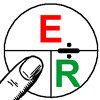Ag Power Web Enhanced Course Materials
Electrical
- Introduction
- Lecture Notes
- Circuit & Relay Demonstrations
- Animated Examples
(Coming Soon) - Job Sheets
- Submitting Job Sheets
- Terms/Definitions
Reference Links
Helpful Links
If you experience any problems with the site, please contact Pete Hoffman immediately so corrections can be made. Pete can be reached on campus, via email at phoffman@swtc.edu or by phone at 1.800.362.3322 ext 2727.
Related Lecture Notes
- Basic Laws & Facts
- Electrical Units of Measurement
- Electrical Component
Concepts - Ohms Law
- Electrical Symbols
- Resistor Color Codes
- Conductors/Wire
- Electrical Troubleshooting
Circuits
Meters
Ohm's Law - Calculating Current
What is Current (I)?
Current is the movement of electrons in a circuit. Electric current
is the movement of electrons from one atom to another in a conductor.
Current is the movement of electrons in a conductor. The more electrons that move in a conductor the more current you have in the circuit. The name for current is AMPERE (I).
(I = E ÷ R) |
Current (I) on the equation is missing and you have the (E) and (R) left. Because they are divided by the horizontal line that means divide the two values. |
 |
This is a simple circuit with a potential
of 12 volts (12 E)
and a resistive load of 1 Ohm (1 Since we know the battery is suppling 12 Volts (E), and there is a resistive load of 1 Ohm (R) placed in series, the current will be: I = 12(E) divided by 1(R) or I = 12 |
Click the term to see examples of Voltage and Resistance.
